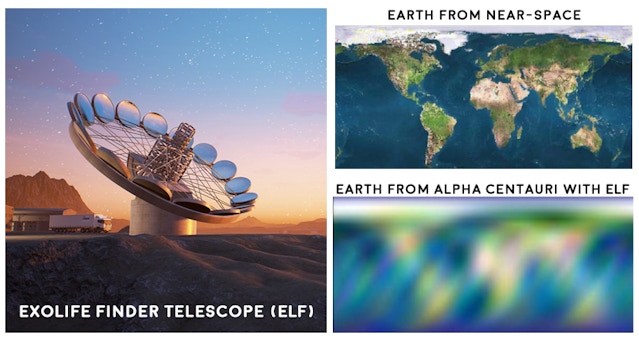As noted by the amazing team
behind this very revolutionary project, their Telescope will be the world’s
first and only telescope easily capable of imaging oceans, continents, and life
on nearby exoplanets. Designed from the ground up, ELF is a new way to build
affordable large-scale telescopes for exoplanetary research.
Highly specialized to see
exoplanets up to 120 trillion miles (24 light years) away from Earth, ELF is
designed for detecting the energy signature of life or life’s likely chemical
fingerprints in the atmosphere from water (H₂O),
oxygen (O), methane (CH₄), and ozone (O₃),
or on the surface from photosynthetic biopigments.
This groundbreaking
telescope would have the ability to see up to 120 Trillion miles into outer
space and discover life beyond Earth. Dubbed as ELF—which stands for ExoLife
finder—the telescope would search the universe for ‘chemical fingerprints’ of
life on the surface of distant alien worlds. The telescope would have the
capability of snapping images go distant alien continents and oceans.
The best part, you can be a
part of it. The project is currently on Kickstarter raising funds.
Once the telescope is
constructed, it will start searching the cosmos with one main goal: Finding
alien life, whether it’s small or big.
In order to do so, it will
start off by exploring its first target—an alien world located in the Proxima
Centauri system dubbed as Proxima B thought to orbit its host star within its
habitable zone. This star system is our closest neighbor located around 4.2
light-years away.
This massive alien hunting
telescope will be composed of sixteen 5-meter mirrors, based on printed mirror
technology according to reports from the Planets Foundation. Once finished, the
telescope is expected to be 25 meters wide and will be located in the Atacama
Desert in Chile. According to initial reports, the ELF telescope would have the
ability to explore distant alien worlds located within 25 light-years from our
sun.
Most excitingly perhaps, it
will have the ability to explore the nearby Alpha Centauri System. Alpha
Centauri is of great interest for Astronomers. Once the ELF telescope is
finished, experts plant to search the neighboring star system and its possible
planets for evidence of life as we know it.
Experts will use the
telescope to sniff out energy signatures of life in its atmosphere, as well as
search the planets’ atmosphere and detected water, oxygen, methane as well as
ozone. However, astronomers note how their revolutionary telescope could even
detect photosynthetic organisms or even traces of thermal waste at the surface
of the planets from advanced alien civilizations.
Dr. Svetlana Berdyugina,
Director of the Kipenheuer Institute for Solar Physics and Planets Foundation,
as well as the co-founder, said: “We aim to find life on nearby planets outside
the solar system, also known as exoplanets.”
“We have designed a
revolutionary telescope with a number of metamaterials, making our mirrors
incredibly light and also reducing the cost of our telescopes by a factor of
10. Our powerful new telescope ExoLife Finder, or ELF, will be able to see
planets up to 120 trillion miles away, and will image oceans, continents, and
life on exoplanets,” added Berdyugina.
Currently, the team behind
the project has raised around $17,000 toward their initial goal of $35,000.
They hope to meet their initial goal soon, hoping everything goes okay.
$35,000 isn’t the price for
the telescope. You can find out more about the telescope by visiting their
Kickstarter page, and planets.life.






